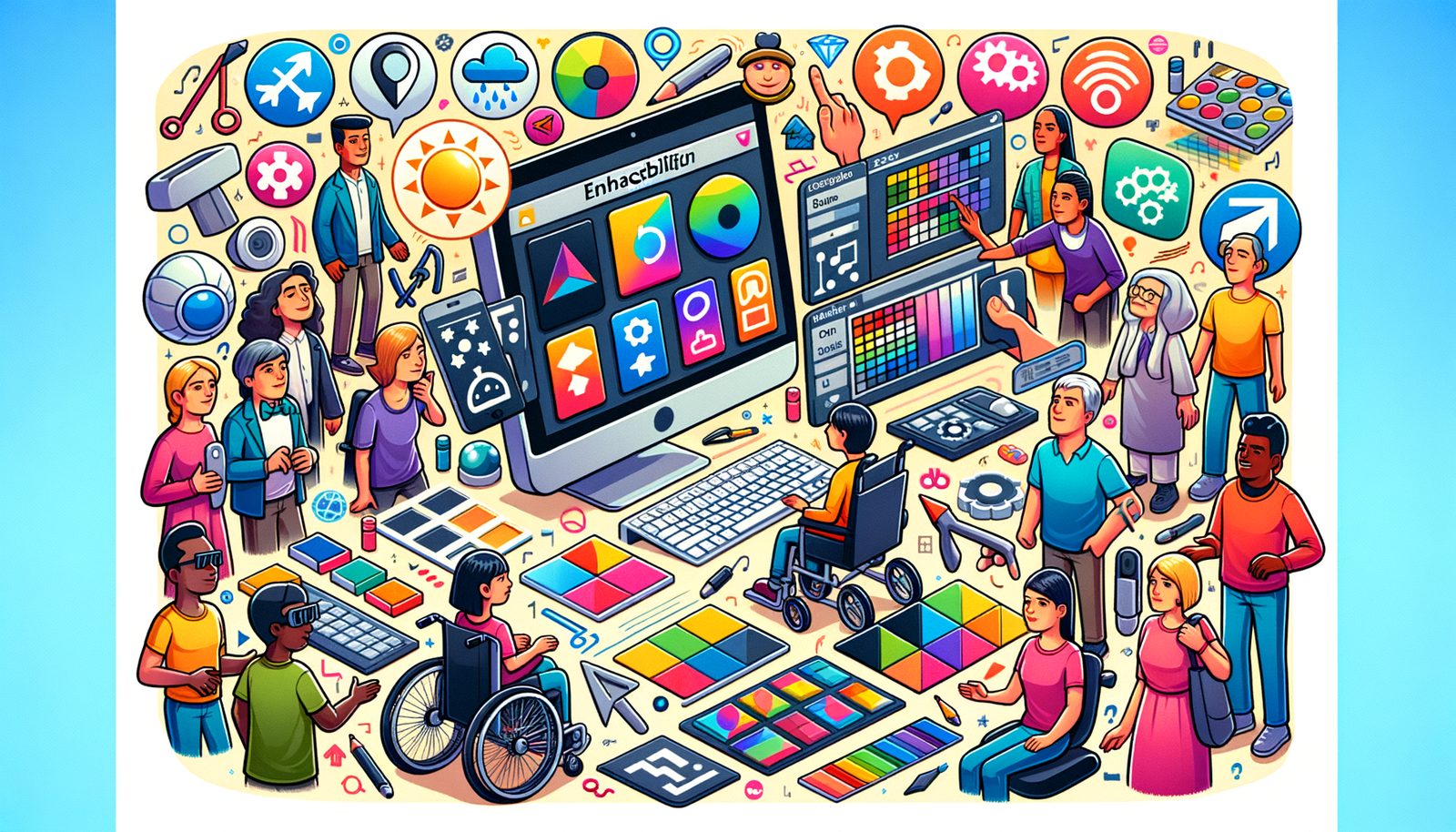Your Cart is Empty
Customer Testimonials
-
"Great customer service. The folks at Novedge were super helpful in navigating a somewhat complicated order including software upgrades and serial numbers in various stages of inactivity. They were friendly and helpful throughout the process.."
Ruben Ruckmark
"Quick & very helpful. We have been using Novedge for years and are very happy with their quick service when we need to make a purchase and excellent support resolving any issues."
Will Woodson
"Scott is the best. He reminds me about subscriptions dates, guides me in the correct direction for updates. He always responds promptly to me. He is literally the reason I continue to work with Novedge and will do so in the future."
Edward Mchugh
"Calvin Lok is “the man”. After my purchase of Sketchup 2021, he called me and provided step-by-step instructions to ease me through difficulties I was having with the setup of my new software."
Mike Borzage
Enhancing Accessibility in Design Software: Key Features, Challenges, and Future Directions
April 07, 2025 5 min read


In today's rapidly evolving technological landscape, accessibility in design applications has become a paramount concern. As software becomes more integral to our daily lives, ensuring that design tools are accessible to all users, regardless of their abilities, is both a moral obligation and a strategic necessity. This comprehensive exploration delves into the multifaceted aspects of accessibility in design software, highlighting its significance, key features, benefits, challenges, and future directions.
Understanding Accessibility in Design Applications
Accessibility in design software refers to the practice of making applications usable by as many people as possible, including those with disabilities. It encompasses a broad spectrum of considerations to accommodate various types of disabilities, such as visual, auditory, motor, and cognitive impairments. By integrating accessibility features, designers and developers ensure that their tools are inclusive, providing equal opportunities for all users to engage with and benefit from the software.
The scope of accessibility is vast, addressing needs such as:
- Visual impairments: Including color blindness, low vision, or complete blindness.
- Auditory impairments: Ranging from partial to total hearing loss.
- Motor disabilities: Affecting fine motor skills, making precise cursor movements challenging.
- Cognitive disabilities: Such as dyslexia, ADHD, or other learning difficulties that impact information processing.
The importance of accessibility extends beyond ethical considerations; it's a critical aspect of inclusive design practices. By prioritizing accessibility, software developers not only comply with legal mandates but also tap into a broader user base. This approach enhances user satisfaction and fosters loyalty, as all users feel valued and accommodated.
User demographics underscore the necessity of accessible design. Statistics reveal that a significant portion of the population lives with some form of disability that can impact their interaction with software applications. By implementing accessibility features, companies can positively affect user retention and satisfaction, leading to increased adoption and usage of their design tools.
Key Accessibility Features in Modern Design Software
Modern design applications have embraced a multitude of accessibility features to address the diverse needs of users. These features are integral to creating an inclusive environment where all users can effectively utilize the software's capabilities.
Visual Enhancements play a crucial role in accommodating users with visual impairments. High-contrast modes and customizable color schemes enable users to adjust the visual output to suit their specific needs. Scalable fonts and adjustable interface sizes ensure that text and graphical elements are legible, reducing eye strain and improving readability.
Input and Navigation options are vital for users with motor disabilities. By providing comprehensive keyboard shortcuts and alternative input methods, users who struggle with traditional mouse navigation can operate the software efficiently. The integration of voice command functionality and gesture controls further expands the accessibility of design applications, offering hands-free operation and ease of use.
Ensuring compatibility with assistive technologies is another key aspect. Screen reader support allows visually impaired users to navigate the software through auditory feedback, while text-to-speech functionality aids those who benefit from listening to content rather than reading. Integration with Braille displays and other assistive devices ensures that the software is usable by individuals with varying degrees of sensory impairments.
Cognitive accessibility tools address the needs of users with learning disabilities or cognitive challenges. Simplified user interfaces with clear navigation paths help prevent confusion and reduce the cognitive load. Features such as error prevention mechanisms and helpful feedback provide guidance, making the software more intuitive and less overwhelming for users who may struggle with complex interfaces.
Benefits of Enhanced Accessibility for Users and Workflows
Incorporating advanced accessibility features in design software yields significant benefits for both users and organizations. One of the primary advantages is the creation of an inclusive user experience. By accommodating a diverse range of needs, software developers can reach a broader user base, tapping into markets that may have been previously inaccessible. This inclusivity not only boosts market reach but also enhances user satisfaction, fostering a sense of loyalty and trust among users.
Enhanced accessibility directly contributes to improved productivity and creativity. Users with disabilities can engage with design tools more effectively, streamlining their workflows and unleashing their creative potential. By reducing barriers to use, organizations encourage diverse perspectives in the design process, leading to more innovative and well-rounded solutions.
Compliance with standards and regulations is another critical benefit. Adhering to accessibility guidelines such as the Americans with Disabilities Act (ADA) and the Web Content Accessibility Guidelines (WCAG) helps organizations avoid legal challenges and penalties. Compliance demonstrates a commitment to ethical practices and social responsibility, which can enhance an organization's reputation.
Finally, a focus on accessibility contributes to a positive brand image. Companies that prioritize accessibility are seen as socially responsible and empathetic, values that resonate with consumers. This positive perception can lead to increased customer loyalty, brand advocacy, and a competitive advantage in the marketplace.
Challenges and Future Directions in Accessibility
Despite the clear benefits, several challenges hinder the seamless integration of accessibility features in design software. Technical limitations often arise when balancing the inclusion of advanced functionalities with the requirements of accessibility. Ensuring compatibility across different platforms and devices adds another layer of complexity, as developers must account for varying system capabilities and user environments.
Design and development hurdles also present significant obstacles. Integrating accessibility features from the early stages of design is crucial, yet it requires a shift in traditional development methodologies. Developers and designers must be trained and made aware of accessibility best practices, which can demand additional resources and time. Overcoming these hurdles necessitates a cultural shift within organizations to prioritize accessibility as a core component of the development process.
Looking ahead, emerging technologies offer promising avenues for enhancing accessibility. The application of artificial intelligence and machine learning enables personalized accessibility solutions tailored to individual user needs. For instance, AI can dynamically adjust interface elements based on user behavior and preferences, creating a more responsive and accommodating experience. The incorporation of virtual and augmented reality technologies also opens new possibilities for immersive and accessible design experiences.
Commitment to ongoing improvements is essential for keeping pace with evolving accessibility standards and user expectations. Establishing continuous feedback loops with users who require accessibility features allows developers to identify areas for enhancement and ensure that the software remains relevant and user-friendly. Staying updated with the latest best practices and technological advancements ensures that accessibility remains at the forefront of design considerations.
Conclusion
Enhancing accessibility features in modern design applications is not only a moral imperative but also a strategic advantage. By implementing comprehensive accessibility tools, design software can cater to a diverse user base, foster inclusive work environments, and comply with essential standards. While challenges remain in balancing functionality with accessibility, ongoing advancements in technology and a commitment to user-centric design promise a more accessible future for all. Embracing these changes will lead to more innovative, efficient, and universally usable design solutions.
Also in Design News

ZBrush Tip: Project All Best Practices: Preserve Sculpt Detail, Polypaint, and Topology
October 28, 2025 2 min read
Read More
AutoCAD Tip: Optimize AutoCAD Layer Management with Layer States and Filters
October 28, 2025 2 min read
Read MoreSubscribe
Sign up to get the latest on sales, new releases and more …



